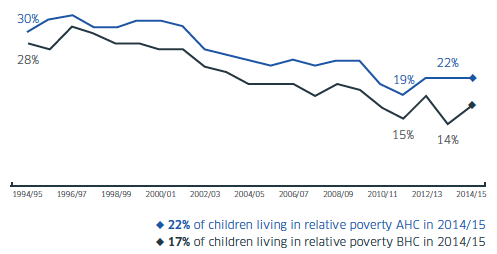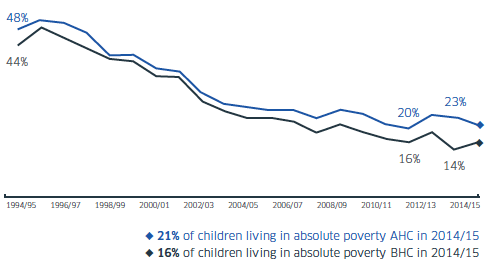Child Poverty Bill: consultation
This consultation sets our proposals for a Child Poverty Bill.
Annex A: Child Poverty in Scotland
Because family low income has a range of complex drivers, the Scottish Government measures child poverty in a number of different ways. Three current measures help us understand the following: whether the incomes of poorer families are keeping up with those on middle incomes; whether poorer families' incomes are keeping pace with inflation; and whether poorer families can afford certain basic necessities. This section describes how Scotland has been performing on these measures over the last 20 years. A fourth measure looking at persistent poverty will be reported on, for the first time, next year. These four measures together were set out as the targets in the UK Government's Child Poverty Act 2010. However, the Scottish Government is proposing that targets should be set on an after housing costs basis. This is a more challenging ambition than the 2020 targets which were set on a before housing costs basis.
Relative poverty is a measure of whether the incomes of the poorest are increasing in line with middle income households. In 2014/15, 17% of children in Scotland were living in relative poverty before housing costs ( BHC), and 22% after housing costs are taken into account ( AHC). Relative child poverty BHC has been decreasing over the long term, though there have been fluctuations in recent years. Relative child poverty AHC has also decreased over the long term, though it increased in 2012/13 and has remained flat since then.
The 2020 target was 10% BHC, so in 2014/15, Scotland was seven percentage points away from meeting that target. The Scottish 2030 target is 10% AHC, so in 2014/15, Scotland was 12 percentage points away from meeting that target.
Relative Poverty in Scotland

Scottish Government analysis of Households Below Average Income dataset, DWP
Absolute poverty is a measure of whether the incomes of the lowest income households are keeping pace with inflation. In 2014/15, 16% of children in Scotland were living in absolute poverty BHC and 21% AHC. As with relative child poverty, absolute poverty had been decreasing over the long term, both before and after housing costs, but has fluctuated in recent years. The 2020 target was 5% BHC, so in 2014/15, Scotland was eleven percentage points away from meeting that target. The Scottish 2030 target is 5% AHC, so in 2014/15, Scotland was 16 percentage points away from meeting that target.
Absolute poverty in Scotland

Scottish Government analysis of Households Below Average Income dataset, DWP
Scotland also has a combined 'low income and material deprivation' measure. This considers whether families on low incomes can afford certain basic necessities. In 2014/15, 10% of children were living in combined material deprivation and low income BHC, and 12% AHC are taken into account. This represents a decrease in combined material deprivation and low income since 2013/14, following two years of increases prior to that. The 2020 target was 5% BHC, so in 2014/15, Scotland was five percentage points away from meeting that target. The Scottish 2030 target is 5% AHC, so in 2014/15, Scotland was seven percentage points away from meeting that target.
Combined material deprivation and low income

Scottish Government analysis of Households Below Average Income dataset, DWP
The fourth 2020 target, on persistent poverty, was set at UK level at 7% BHC. The UK only recently published its first estimates of persistent poverty, because of data issues. The proposed Scottish target is 5% AHC. The first Scottish estimates are expected next year.
Contact
Email: Gillian Cross, childpovertyconsultation@gov.scot
There is a problem
Thanks for your feedback